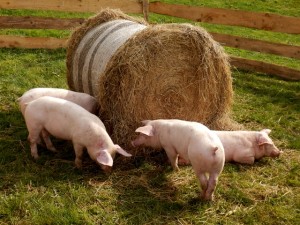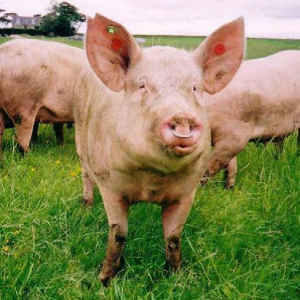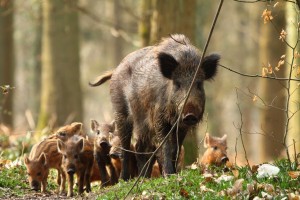Understanding Behaviour

The provision of straw gives an important stimulus and outlet for exploration, foraging, rooting and chewing behaviours
A good understanding of animal behaviour is required if we are going to achieve our objective of enabling animals in our care to express their basic behavioural needs (Lund and Weary, 2004). A basic understanding of natural behaviour can be obtained from observing animals under natural conditions or in the wild. Natural behaviour can be defined as the repertoire of different behaviours animals show when kept in environments where they can carry out behaviours created in the evolutionary process (Lidfors et al., 2005). Motivation and innate behaviours are important aspects of natural behaviour, and hindering them may lead to abnormal behaviour and stress (see also Housing and behaviour).
Studies of domestic pigs that have escaped back into the wild have shown that their behaviour closely resembles that of the European wild boar (Sus scrofa) from which they originated. An understanding of the natural behaviour of pigs can therefore help us to identify and improve pig welfare and to design systems that enhance positive welfare conditions. Despite domestication, pigs have inherited many of the behaviours and ethological needs of their wild ancestors and welfare problems arise when these natural behaviours and needs cannot be met.
Environmental Enrichment
Environmental enrichment is often implemented without considering the requirements of the animals within their environment and without specifying desired functional behaviours. Enrichment stimulates foraging and explorative behaviour (Van de Weerd et al., 2003). It has been shown that low social status is associated with increased injuries to the head, neck and ears, and therefore reduced welfare. Environmental enrichment may improve the welfare of growing pigs with low social status (O’Connell et al., 2004c).
- Is the enrichment and or manipulable material provided for the pigs keeping the pigs occupied productively i.e. is it what they choose to root or chew? Pigs rooting or chewing other pigs, muck or pen fittings indicate motivation to root but lack of desirable outlet.
- Pigs have evolved as opportunistic omnivores who use rooting behaviour as a tool for finding food and the correct balance of nutrients.
- We have not bred out the need for our domesticated pigs to root with their snout and manipulate materials with their mouth.
- Domestic pigs continue to root in the absence of food rewards – there is evidence that this behaviour has become ‘hard-wired’ as strongly selected for in past evolution.
- Studies have shown that free-living and farmed pigs spend the majority of their active time investigating and manipulating.
- Farms need to provide suitable manipulable substrate or objects to keep pigs occupied. Failure to do so can increase risk of tail biting outbreaks.
from AHDB Pork Real Welfare scheme
The amount of time occupied by enrichment-related behaviour increases with age. However, weaners and growers appear to be stimulated by the same properties of enrichment items. Preparturient sows are highly motivated to obtain nesting material and straw can have a beneficial effect on maternal behaviour after farrowing. It has been shown to be more effective than most materials in providing sustained occupation and reducing pig directed negative behaviours and vices (The University of Newcastle, 2003). Pigs seem to prefer long straw provided via a rack, spending longer periods in contact with the straw and less negative behaviour to others compared to when chopped straw is given via a dispenser (Bulens et al., 2015) .
Nest building and maternal behaviour
Farrowing environment and the opportunity to construct a nest are two important behavioural requirements (Damm et al., 2003). Behaviour during nest building and farrowing is related to the general reaction pattern during stress, especially in inexperienced gilts, and since the performance reflects an innate pattern of reaction in the individual, that can be modified by the environment and previous experience (Thodberg et al, 2002a). A stimulating farrowing environment has been shown to improve maternal behaviour (Thodberg et al, 2002b). In extensive circumstances, maternal behaviour in the peripartal period will have a much greater effect on piglet survival than in intensive conditions (Boe, 1993).
Rooting Behaviour

A nose ring is normally inserted into the septum (the cartilage between the nasal cavities), as shown here, or the flat disc of cartilage at the end of the pig’s snout
Rooting behaviour appears to be an important part of the behavioural repertoire, a rewarding experience and perhaps a behavioural need (Studnitz et al., 2003). The pigs’ natural inclination to root can also provide a useful cultivation and weeding tool (Lund and Weary, 2004). However, rooting can also lead to environmental damage. There are apparently no real differences between rotational and set-stocked systems with regard to levels of rooting, foraging and feeding behaviour (Day et al., 2003).
Keeping pigs on the right soil type and the use of rotational grazing is key to the exploitation of the former and minimising the impact of the latter. A system of integrating pigs into a crop rotation is described by Lund and Weary (2004) whereby a once a year farrowing herd is moved periodically within a crop rotation programme. See also Outdoor Access for more on integrating pigs into crop rotations.
Under semi-natural conditions, sows spend 10-20% of their active time rooting. The welfare consequences of rooting deprivation depend on the motivation of the behaviour (Studnitz and Jensen, 2002). Levels of rooting behaviour are flexible in response to nutritional needs. Restricting feed levels to 70 or 80% of appetite can lead to a significant increase in active rooting and in non-rooting activity during peak periods (Beattie and O’Connell, 2002).
Although the provision of root crops can reduce rooting behaviour, this is not an exclusive determinant of paddock damage, and cannot be recommended as the sole alternative to nose-ringing (Edge et al., 2005). Manipulation of edible substrates may substitute for rooting behaviour in outdoor sows. Sows that received silage as overground enrichment spend less time rooting the paddock (Edge et al., 2004).
Sows have a preference for peat and branches as rooting materials compared with straw, chopped or otherwise (Pedersen et al., 2005).
Nose Ringing
Refer to AWA document on Nose Ringing Pigs

In the wild pig under natural conditions, aggression and fighting is not common and normally occurs between competing males or when food is concentrated in few places during certain times of the year (photo from http://circleranchtx.com/)
Social Behaviour
Social behaviour is highly developed in pigs. Within hours, newborn piglets begin to form social dominance relationships with littermates and eventually a stable hierarchy is formed. In the wild pig under natural conditions, aggression and fighting is not common and normally occurs between competing males or when food is concentrated in few places during certain times of the year.
Additional information on Pig Behaviour can be found at http://www.animalbehaviour.net/pigs/


 American English
American English

Comments are closed.